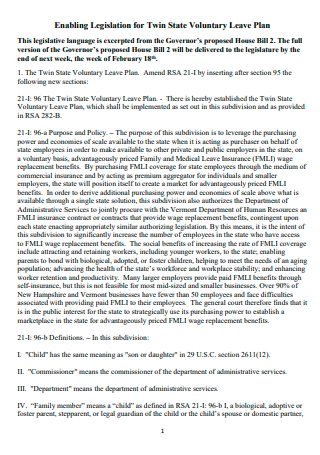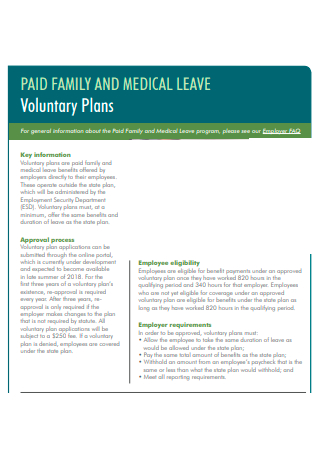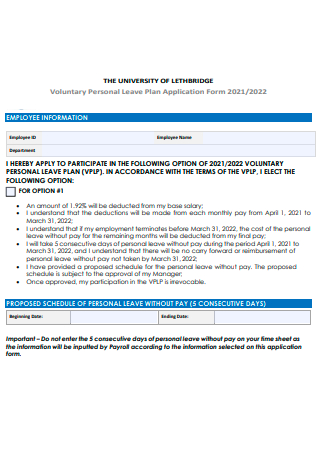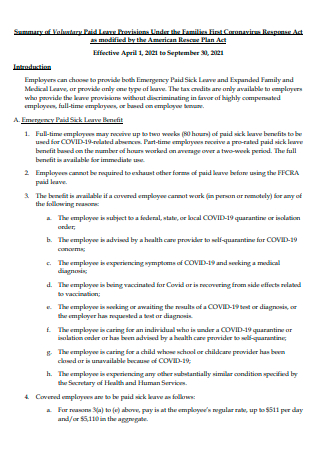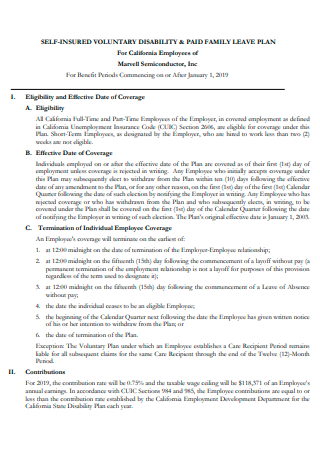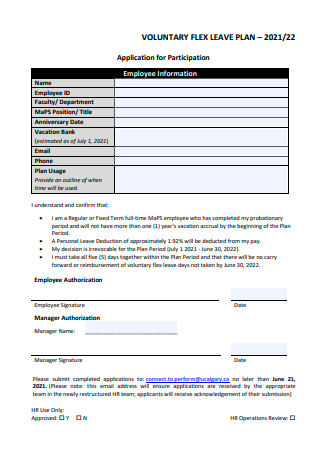5+ Sample Voluntary Leave Plan
What Is a Voluntary Leave?
Employees are on voluntary leave when they take a break from work without pay. Voluntary leave is an advantageous alternative to layoffs for companies experiencing downsizing, financial constraints, or general reorganization. In 2020, the average annual turnover rate across the nation was 57.3%. Additionally, companies lose 18% of their workforce annually due to turnover.
Benefits of Paid Leave for Business
Paid leave policies may incur additional expenses, but their benefits more than offset those costs. Research indicates that providing paid leave benefits the employee, the employer, and the economy as a whole. While budget-conscious business owners may initially be wary of the additional expenses on the balance sheet, the numbers indicate that paid leave is prudent. Paid leave can be advantageous for your business, although you may dislike paying employees for time off. Here are several reasons why paid leave benefits firms.
Types of Leaves
For many businesses, a leave policy communicates employees’ paid leave days and national holidays. However, leave policies are more significant than you might think. The majority of candidates who a company is recruiting inquire first about the organization’s leave policy. In addition to the number of leaves, prospective employees want to know the types of leaves the company offers for various needs and emergencies. Here are six types of leaves that your leave policy must accommodate:
1. Sick leave
An employer grants sick leave to allow employees to recover from an illness and attend to their health. Sick leave is essential for employees to rest without worrying about losing pay. In many countries, sick leave is required to ensure the employee’s health. Employers must provide employees with 15 days of sick leave per year. However, you must also be flexible with your sick leave policies and allow employees with serious health issues to take longer leaves. In many businesses, unused sick days are carried over next year. However, you must request sick leave from your employees.
2. Casual leave
Employees take casual leave for travel, vacation, rest, and family obligations. Such leaves allow the employee to take time off for significant life events, such as attending a wedding or traveling to another country. Providing the employee with paid time off will allow them to prioritize their personal life when necessary and make them feel valued by the company. In most companies, employees are permitted between 8 and 15 days of unscheduled leave per year.
3. Public holiday
Public holidays are days on which the government grants leave. Every institution must observe these holidays, including schools, banks, government offices, and private businesses. Independence Day, Memorial Day, Labor Day, bank holidays, and any nationally-recognized day, such as the death of a prominent leader, are examples of public holidays. Include these leaves within your leave policy by researching the government-mandated holidays in your country.
4. Religious holidays
Christmas, Eid, Easter, Holi, and Yom Kippur are all religious holidays your employee likely celebrates and would want the day off to spend with their family and observe the festival. It would help if you accommodated these holidays by allowing employees to take time off on the festival day. Please take note of every religious holiday from online resources and request that employees send you an annual message listing the religious holidays for which they require time off.
5. Maternity leave
From caring for the infant to recovering from childbirth, maternity leave is a crucial period for new mothers. Ensure that your policy accommodates this type of leave so that employees can focus on their newborns without worrying about their jobs. The new mother is granted 7 and 17 weeks of maternity leave, depending on the company’s home country. Fourteen weeks is a sufficient amount of time to give the mother so that she can care for her newborn for the first three months. It would help if you also were willing to offer additional leave days in the event of postnatal complications.
6. Paternity leave
New fathers—husbands or partners of a pregnant woman, surrogate parents, or adoptive parents—are granted paternity leave to care for their newborns without worry. Unlike maternity leaves, new fathers typically receive two weeks of paternity leave after their child’s labor. Some countries require new fathers to take one to two weeks of paternity leave. Since such leaves are not mandated by law, employers rarely offer paternity leave upon the birth of a child. However, human resources must recognize the stresses associated with adjusting to a newborn and caring for a child in the first few days.
How to Write a Leave Request Email
Creating a professional leave request email can assist you in preserving your relationship with your employer. This formal document may inform the company of your extended absence and the duration of your absence. Employers can better understand your lack and recognize your professionalism if you tell them the reasons for it. Here is a straightforward guide for writing a request to leave:
1. Plan your email
The structure of your request can be enhanced by planning what you might say to the employer. Mention the type of leave, your reasons, the date of your departure, the date of your return, your last shift before your departure, which could cover your position, and your emergency contact information if the company wishes to discuss your absence further. This information may convince your employer to grant your request for an extended leave of absence. You may use bullet points to ensure that your plan contains all pertinent information.
2. Write down your request
Typically, the opening paragraph includes the reason for the email and requesting time off. Mentioning your leave and return dates can inform your employer of the length of your potential absence. The employer may be more inclined to approve the request if you include this information first in your formal document. Keeping this introduction brief will allow you to make your point quickly.
3. Justify your response
When writing the second paragraph, it may be helpful to include your reasons and how they interfere with your work schedule. Employers prefer to know the reason for your absence so that they can arrange for someone to take over your daily responsibilities for a specified period. When approaching the company’s regulations, explaining can also enhance your professionalism. If the reason is too private, you can explain your request briefly.
4. Convince the employer
Crafting a reassuring statement near the conclusion of the email can assist the employer in adjusting work schedules to accommodate your absence. You can describe potential replacements for your position and how they can accomplish daily tasks. Before your leave begins, it may be prudent to indicate how you can assist your employer. For instance, you may complete upcoming projects before the deadline, which can be advantageous to the companies and future work schedules.
5. Express gratitude
Most employers value gratitude from team members, as it demonstrates professionalism and commitment to the organization. You can thank them in advance for their consideration and acknowledge their time spent reading the email. This sentence can be brief and could end positively for the formal document. Thanking your employer can strengthen your professional relationship with them.
FAQs
Are planned leaves paid?
Planned leaves are typically paid, as the employee has complete control over when to apply. Similarly, depending on the length of the leave, the employee may be required to notify their manager or supervisor in advance to obtain timely approval.
Why is leave policy important?
Paid leaves assist employees in their time of need without causing them to lose income. Paid vacations allow workers to relax and recharge. According to research, an employee-friendly leave policy increases employee satisfaction, loyalty, and output.
What is PL leave?
Privilege leaves are accrued leaves credited to employees by their employer. These leaves may be utilized for vacation, rest, marriage, and medical emergencies. Since these are long-term leaves, you must request a minimum of 3 days off 7 to 14 days in advance.
As the HR department, you must have a thorough understanding of all aspects of this document’s creation to provide your employees and constituents with accurate information. Creating a Voluntary Leave Plan will assist you in gaining their understanding of this matter. This article helped you develop one, from the templates above to the pertinent information that must be noted.

